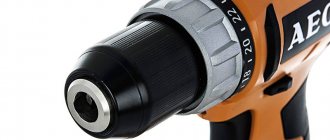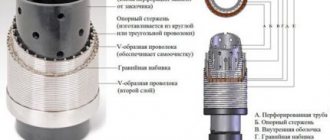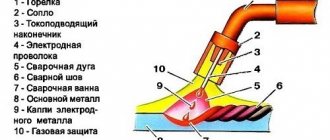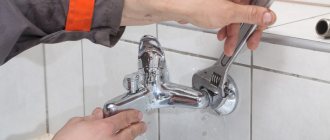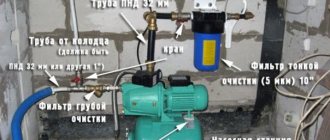The most widespread among professional builders in Russia are Bosch rotary hammers, and among amateurs the household models Bosch 2-20, 2-24, 2-26. Rotary hammers not only work well, but are also easy to repair. You can easily find any broken part on them.
The designs of the described rotary hammers are based on the same principle: transmitting torque from the rotor to the shaft of the impact block barrel while simultaneously transmitting a translational impulse to the working tool.
Structurally, hammer drills are made according to the same design, but individual components or parts have their own characteristics.
If you know the specific differences between the models of the described Bosch rotary hammers, then disassembling and repairing them yourself will not be difficult.
Along with the originals, there are a large number of counterfeit tools on the Russian market, including Bosch rotary hammers. Below we describe the design features of the models and how to disassemble and repair them yourself.
The operating principle of rotary hammers is the same, but the design features differ.
The main parts used in the listed models of Bosch rotary hammers are interchangeable. This applies to the mechanical and electrical components.
But there are units made that differ in the parts used.
To repair a Bosch 2-20, 2-24, 2-26 rotary hammer, you need to know these differences. Knowledge of the design features of each rotary hammer facilitates the repair process, finding breakdowns and eliminating them.
The designs of Bosch rotary hammers are so simple that they allow you to perform simple repairs, practically with your own hands, and replace any part without contacting service departments. You must have assembly skills, have basic knowledge of electrical engineering and understand the principle of operation of a rotary hammer.
The main differences in the designs of Bosch rotary hammers
When repairing a Bosch rotary hammer, you cannot do without an electrical diagram and a disassembly diagram for the tool of the model you are going to repair.
The electrical circuits of Bosch 2-20, 2-24, 2-26 rotary hammers are almost the same. Although there are some unprincipled differences.
But mechanical blocks are equipped with parts that differ structurally from each other. The main differences are concentrated in two units: the intermediate shaft and the barrel shaft of the shock block.
The greatest differences are presented in the design of the intermediate shaft, the “drunk bearing” assembly, and the mode switch. Unprincipled features are present in the design of the barrel of the striker block, firing pin, and striker.
Let's start with the Bosch 2-20 rotary hammer.
Signs of a fake
Due to the great popularity of the equipment presented, cases of counterfeiting are not uncommon. There are characteristic features that define a fake HR 2450 hammer drill. These include a short cord (about 0.5 m). The letters on the black clasps of the suitcase are matte on the fake, but on the original. shiny.
In the photo of the hammer drill in the instructions for this product, the background is light gray, almost white. The copy will have a dark, dull color in the background of the image.
If the HR 2450 case shows Japan as the manufacturer, it is not a genuine instrument. The original says: Made in PRC, i.e. made in China.
The Makita 2450 includes a rubberized handle that is marked with the serial number. All parts of the suitcase must also each contain its own designation. The fake handle is made not of rubber, but of plastic. This should also be a signal about the need to refuse to purchase such an instrument.
Diagram and design of the Bosch 2-20 rotary hammer
Repairing a Bosch 2-20 rotary hammer is not possible without knowledge of the design of the tool being repaired.
The operating principle of the Bosch 2-20 rotary hammer is based on the transmission of torque from the rotor shaft pos. 3 to the impact block shaft pos. 22 through the intermediate shaft pos. 824, while simultaneously transmitting longitudinal impulse to the working tool.
Rotor pos. 3 transmits torque to the helical gear of the intermediate shaft pos. 824.
The helical gear is mounted on the intermediate shaft and transmits rotational torque to the shaft. A fixed bearing is attached to the shaft, receiving rotational torque through the clutch. Due to its design, the drunk bearing transmits translational motion to the barrel cylinder of the impact mechanism.
Design of the intermediate shaft of the Bosch 2-20 rotary hammer
The intermediate shaft of a Bosch 2-20 hammer drill consists of a rolling bearing assembly (drunk bearing), a clutch, a large helical gear, and a small spur gear.
Most often, breakdowns manifest themselves in wear of the clutch splines, which leads to the loss of rotation of the hammer drill chuck in the presence of a shock pulse.
It can be corrected by replacing the clutch or restoring the teeth of the clutch parts.
Do-it-yourself Bosch rotary hammer repair
If any parts in the tool are damaged, broken, or do not perform their function well, then they simply need to be replaced. If the brushes are worn out, then during disassembly they are simply replaced with new ones. When the rim rotates slowly, the hammer drill cartridge, worn boot, and failed bearings are also replaced. But there are other problems that you can fix. If a breakdown of the winding occurs, then the stator and armature must be rewinded. You need to monitor the lubrication and lubricate some parts from time to time.
Repair of Bosch 2 26 rotary hammers
Before you fix anything in this model, you need to familiarize yourself with the features of the device, the circuit and the principle of operation. The rotor shaft transmits rotation to the barrel shaft through an intermediate shaft, the bearing of which directs the return movement to the impact piston.
When disassembling the barrel shaft in the impact block, you need to pay special attention to fixing the spur gear. Before removing it, you need to remove the 3 pins that secure it in this model.
Repair of Bosch 2 24 rotary hammers
In this bosch gbh 2 24 dsr hammer drill, the intermediate shaft consists of a switching part, a bearing assembly and a clutch. The latter deteriorates most often because its teeth wear out quickly. Repairing this damage consists of correcting the profile of the engagement teeth. You can often notice that there is no impact. The hammer drill may gradually stop chiseling due to wear of the rubber parts, which need to be replaced in time. And if you apply more force than necessary, this can lead to the firing pin jamming in the impact piston.
Repair of Bosch 2-28 rotary hammers
In this model of tool, the splines sometimes wear out. In this case, it is necessary to disassemble the gearbox (it is almost similar to the Bosch 2-24, only the bearing is different). It is better to replace the entire barrel, because along with the splines, the firing pins also wear out.
As you can see, you can repair rotary hammers at home with your own hands. At the same time, do not spend large sums on various types of repairs in service centers, which, as we know, are very expensive. But do not forget that you must adhere to the rules of use and safety precautions.
The most widespread among professional builders in Russia are Bosch rotary hammers, and among amateurs the household models Bosch 2-20, 2-24, 2-26. Rotary hammers not only work well, but are also easy to repair. You can easily find any broken part on them.
The designs of the described rotary hammers are based on the same principle: transmitting torque from the rotor to the shaft of the impact block barrel while simultaneously transmitting a translational impulse to the working tool.
Structurally, hammer drills are made according to the same design, but individual components or parts have their own characteristics.
If you know the specific differences between the models of the described Bosch rotary hammers, then disassembling and repairing them yourself will not be difficult.
Along with the originals, there are a large number of counterfeit tools on the Russian market, including Bosch rotary hammers. Below we describe the design features of the models and how to disassemble and repair them yourself.
The operating principle of rotary hammers is the same, but the design features differ.
The main parts used in the listed models of Bosch rotary hammers are interchangeable. This applies to the mechanical and electrical components.
But there are units made that differ in the parts used.
To repair a Bosch 2-20, 2-24, 2-26 rotary hammer, you need to know these differences. Knowledge of the design features of each rotary hammer facilitates the repair process, finding breakdowns and eliminating them.
The designs of Bosch rotary hammers are so simple that they allow you to perform simple repairs, practically with your own hands, and replace any part without contacting service departments. You must have assembly skills, have basic knowledge of electrical engineering and understand the principle of operation of a rotary hammer.
Design features of the Bosch 2-24 rotary hammer
It is best to start repairing a Bosch 2-24 rotary hammer by becoming familiar with the circuit and design features of the tool being adjusted. The operating principle of the Bosch 2-24 rotary hammer is similar to the operating principle of the Bosch 2-20 rotary hammer.
The torque is transmitted to the tool mounting shaft, simultaneously with the transmission of the shock impulse. The hammer drill has three operating modes: drilling with impact, drilling without impact, impact.
The helical gear of the rotor pos. 803 transmits torque to the helical gear of the intermediate shaft pos. 826.
Design of the intermediate shaft of the Bosch 2-24 rotary hammer
The intermediate shaft of a Bosch 2-24 rotary hammer consists of a rolling bearing assembly, pos. 830, a clutch, pos. 823, and a switching part, pos. 44. Most often, the clutch fails. The teeth in it wear out. Repair of the coupling consists of correcting the profile of the engagement tooth in the coupling and on the intermediate shaft.
Impact mechanism barrel shaft design
The barrel shaft of the impact block is designed to transmit a rotational impulse with simultaneous movement of the striker.
Rotation is transmitted from the spur gear of the intermediate shaft to the large spur gear pos. 22 of the barrel shaft pos. 821.
The reciprocating motion is transmitted through the driven bearing pos. 830, the impact piston pos. 26, the striker pos. 27, the impact bolt pos. 28 to the drill fixed in the chuck pos. 756.
The design is a shaft, hollow on one side. Parts are installed on the shaft on both sides.
From the side of the cartridge mounting, a spur gear, pos. 22, is installed on the shaft and fixed on the shaft using a roller, pos. 88, and pressed against the shaft collar with a spring, pos. 80. The spring itself is fixed with a locking ring pos. 85.
The following is inserted into the cavity of the impact block barrel shaft: the assembled impact bolt pos. 28 and the impact piston. The striker pos. 27 is inserted into the impact piston pos. 26 with a new rubber ring pos. 73 placed on it. All rubber products are lubricated with the recommended lubricant.
Malfunctions of the hammer shaft shaft
Due to the weakening of the spring force and the locking roller falling out, the gear may rotate on the shaft. This manifests itself in the disappearance of the torque with the presence of a shock pulse.
The rotary hammer hammers, but does not drill.
When rubber products (sealing rings) wear out, the hammer drill stops working in the “Slotting” mode. This happens gradually. The impact force weakens as the rubber rings wear. The thing is that from the drunk bearing the movement is transferred to the impact piston pos. 26, in which the striker pos. 27 creates air pressure and acts on the impact bolt pos. 28.
The hammer drills, but does not chisel.
If you apply a lot of force when operating a hammer drill, this can lead to the destruction of the impact bolt and jamming of the striker in the impact piston. Such malfunctions can only be eliminated by completely replacing the failed part. Learn more about troubleshooting a Bosch rotary hammer.
Electrical faults
Serious problems can also be caused by malfunctions associated with the electrical part of the hammer drill. By the way, a failure to operate can be caused by a trivial lack of voltage in the outlet.
By the way, troubleshooting should start with less. That is, you need to check the presence of power in the electrical network, the integrity of the wire and socket.
By and large, if an instrument does not show any signs of life, the likelihood is that it is the electrical part of the instrument that has failed. The main electrical defects include the following:
No voltage in the supply network, cable break
You can connect any electrical device to check. If there is voltage in the network, then it is necessary to check the integrity of the cable.
To identify this defect, inspect it, then, using a tester, ring it. To eliminate a cable break, you can either solder it or twist it. But it's best to replace it.
Start button malfunction
The cause of this defect may be simple oxidation of the contacts in the button. To check this assumption, it is necessary to dismantle the rear cover of the casing. If there are no visible signs of oxidation, it is advisable to use a tester. To correct this problem, you can clean the contacts, but it is better to replace the power button.
Erasing brushes
With prolonged and intensive use of a hammer drill, wear occurs on the brushes through which electric current flows to the motor. When worn too much, they begin to spark and a burning smell appears. The brush must be at least 8 mm long.
Once this and a smaller size are reached, they are replaced. The replacement procedure is quite simple and anyone can handle it, even if they are not familiar with the basics of electrical engineering.
Speed controller failure
If this problem is detected, it is advisable to replace the entire assembly. But, in fairness, it should be noted that this defect does not occur often.
Motor malfunction
This is probably the worst defect that can happen to an electric tool. The user must understand that it is better not to repair the engine independently. For this purpose, there are specialized workshops equipped with all the necessary repair and diagnostic equipment.
When the engine is running, a certain layer of carbon deposits forms on the manifold. You can remove it yourself and then try to turn it on. If this operation does not help, then it is necessary to ring the armature and stator. There are certain requirements for winding resistance.
Repair of these components can only be carried out in an electrical workshop. It is permissible to perform this work at home, but only if you have special equipment and certain knowledge regarding the operation of the electric motor. This operation, performed at home, will significantly reduce the cost of repairing the rotary hammer as a whole.
Important! Repair of the device is carried out with the tool disconnected from the electrical network.
Design features of the Bosch 2-26 rotary hammer
Repair of a Bosch 2-26 rotary hammer should begin with familiarization with the design features of the tool being adjusted. The operating principle of the Bosch 2-24 rotary hammer is similar to the operating principle of the Bosch 2-26 rotary hammer.
Rotation is transmitted from the rotor shaft, through the intermediate shaft, to the shaft of the impact barrel. At the same time, a bearing mounted on the intermediate shaft transmits reciprocating motion to the impact piston.
The hammer drill has three operating modes: drilling with impact, drilling without impact, impact.
The helical gear of the rotor pos. 803 transmits torque to the helical gear of the intermediate shaft pos. 823.
The intermediate shaft is similar to the shaft in the design of the Bosch 2-24 rotary hammer and is interchangeable with parts included in the intermediate shaft of the Bosch 2-24, 2-26 rotary hammers. Instructions for disassembling a Bosch rotary hammer.
Impact mechanism barrel shaft design
The barrel shaft of the impact block is similar in design to the barrel shaft of the Bosch 2-24 rotary hammer. Breakdowns are caused by malfunctions of the same parts as in the Bosch 2-24 rotary hammer.
Features of the Bosch 2-26 rotary hammer shaft are that the driven large spur gear, pos. 22, is fixed on the shaft with three pins, pos. 37, in contrast to the locking roller in the Bosch 2-26 rotary hammer.
When disassembling the barrel shaft of the impact block of the Bosch 2-26 hammer drill, pay attention to the method of fixing the gear. Before removing the gear, three pins must be removed. The procedure for correctly assembling a Bosch rotary hammer.
How to repair it yourself?
Even professional, careful users sometimes break hammer drills. But you can do something yourself to correct the situation. Without contacting specialized repair centers, it is possible to replace brushes and starters, bearings and switches, even the power cord. Light hammer drills will most likely be able to repair houses.
It is not recommended to repair serious professional instruments with your own hands.
Disassembling the hammer drill is as follows:
- sequentially remove the end part, the washer, the spring and the ball;
- unlock the case;
- remove the ends of the wire supplying the stator;
- pull out the brush holder;
- move the gearbox and housing apart so that the switch can be pulled out;
- holding the body in a vice, remove the necessary parts;
- they are replaced or cleaned;
- put everything back together in reverse order.
Next, see the review of the Hammer PRT650A rotary hammer.
Repair of a rotary hammer with a vertical motor.
Conclusions:
• Knowing the differences between the above models of Bosch rotary hammers will allow you to quickly disassemble the tool and replace faulty parts. To do this, you do not need to contact customer service.
• Structurally, Bosch rotary hammers are so simple that they allow you to carry out repairs of almost any complexity.
• All you need is desire and basic knowledge of mechanics.
It happens that you come across counterfeit models of Bosch hammer drills. Read more about this.
